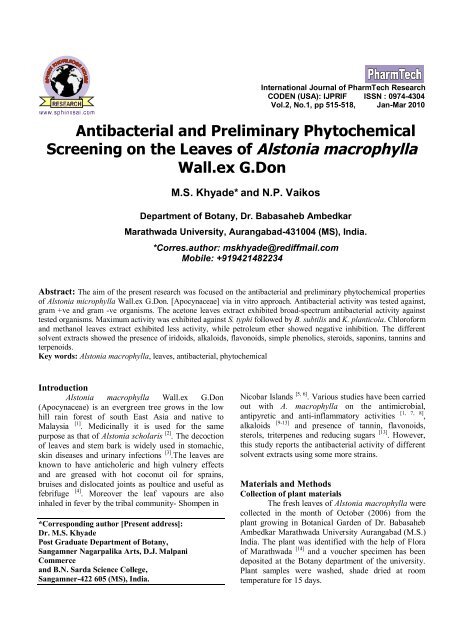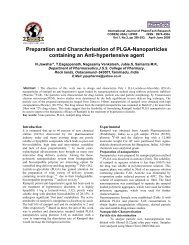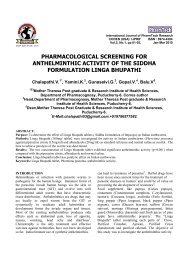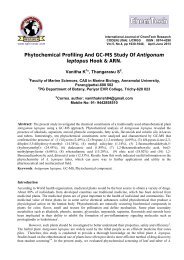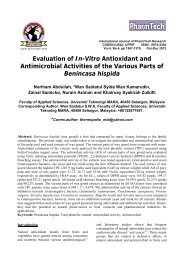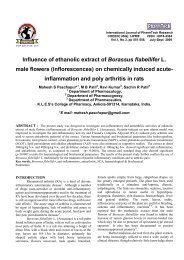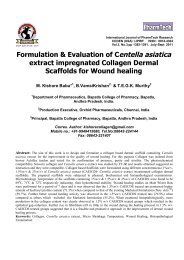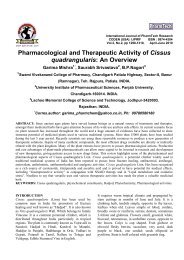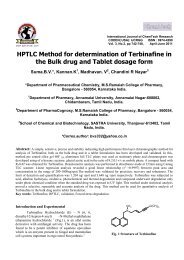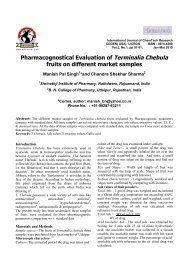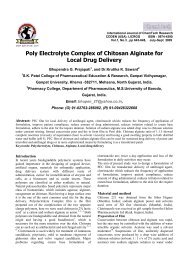Antibacterial and Preliminary Phytochemical Screening on the ...
Antibacterial and Preliminary Phytochemical Screening on the ...
Antibacterial and Preliminary Phytochemical Screening on the ...
Create successful ePaper yourself
Turn your PDF publications into a flip-book with our unique Google optimized e-Paper software.
Internati<strong>on</strong>al Journal of PharmTech Research<br />
CODEN (USA): IJPRIF ISSN : 0974-4304<br />
Vol.2, No.1, pp 515-518, Jan-Mar 2010<br />
<str<strong>on</strong>g>Antibacterial</str<strong>on</strong>g> <str<strong>on</strong>g>and</str<strong>on</strong>g> <str<strong>on</strong>g>Preliminary</str<strong>on</strong>g> <str<strong>on</strong>g>Phytochemical</str<strong>on</strong>g><br />
<str<strong>on</strong>g>Screening</str<strong>on</strong>g> <strong>on</strong> <strong>the</strong> Leaves of Alst<strong>on</strong>ia macrophylla<br />
Wall.ex G.D<strong>on</strong><br />
M.S. Khyade* <str<strong>on</strong>g>and</str<strong>on</strong>g> N.P. Vaikos<br />
Department of Botany, Dr. Babasaheb Ambedkar<br />
Marathwada University, Aurangabad-431004 (MS), India.<br />
*Corres.author: mskhyade@rediffmail.com<br />
Mobile: +919421482234<br />
Abstract: The aim of <strong>the</strong> present research was focused <strong>on</strong> <strong>the</strong> antibacterial <str<strong>on</strong>g>and</str<strong>on</strong>g> preliminary phytochemical properties<br />
of Alst<strong>on</strong>ia microphylla Wall.ex G.D<strong>on</strong>. [Apocynaceae] via in vitro approach. <str<strong>on</strong>g>Antibacterial</str<strong>on</strong>g> activity was tested against,<br />
gram +ve <str<strong>on</strong>g>and</str<strong>on</strong>g> gram -ve organisms. The acet<strong>on</strong>e leaves extract exhibited broad-spectrum antibacterial activity against<br />
tested organisms. Maximum activity was exhibited against S. typhi followed by B. subtilis <str<strong>on</strong>g>and</str<strong>on</strong>g> K. planticola. Chloroform<br />
<str<strong>on</strong>g>and</str<strong>on</strong>g> methanol leaves extract exhibited less activity, while petroleum e<strong>the</strong>r showed negative inhibiti<strong>on</strong>. The different<br />
solvent extracts showed <strong>the</strong> presence of iridoids, alkaloids, flav<strong>on</strong>oids, simple phenolics, steroids, sap<strong>on</strong>ins, tannins <str<strong>on</strong>g>and</str<strong>on</strong>g><br />
terpenoids.<br />
Key words: Alst<strong>on</strong>ia macrophylla, leaves, antibacterial, phytochemical<br />
Introducti<strong>on</strong><br />
Alst<strong>on</strong>ia macrophylla Wall.ex G.D<strong>on</strong><br />
(Apocynaceae) is an evergreen tree grows in <strong>the</strong> low<br />
hill rain forest of south East Asia <str<strong>on</strong>g>and</str<strong>on</strong>g> native to<br />
Malaysia [1] . Medicinally it is used for <strong>the</strong> same<br />
purpose as that of Alst<strong>on</strong>ia scholaris [2] . The decocti<strong>on</strong><br />
of leaves <str<strong>on</strong>g>and</str<strong>on</strong>g> stem bark is widely used in stomachic,<br />
skin diseases <str<strong>on</strong>g>and</str<strong>on</strong>g> urinary infecti<strong>on</strong>s [3] .The leaves are<br />
known to have anticholeric <str<strong>on</strong>g>and</str<strong>on</strong>g> high vulnery effects<br />
<str<strong>on</strong>g>and</str<strong>on</strong>g> are greased with hot coc<strong>on</strong>ut oil for sprains,<br />
bruises <str<strong>on</strong>g>and</str<strong>on</strong>g> dislocated joints as poultice <str<strong>on</strong>g>and</str<strong>on</strong>g> useful as<br />
febrifuge [4] . Moreover <strong>the</strong> leaf vapours are also<br />
inhaled in fever by <strong>the</strong> tribal community- Shompen in<br />
*Corresp<strong>on</strong>ding author [Present address]:<br />
Dr. M.S. Khyade<br />
Post Graduate Department of Botany,<br />
Sangamner Nagarpalika Arts, D.J. Malpani<br />
Commerce<br />
<str<strong>on</strong>g>and</str<strong>on</strong>g> B.N. Sarda Science College,<br />
Sangamner-422 605 (MS), India.<br />
Nicobar Isl<str<strong>on</strong>g>and</str<strong>on</strong>g>s [5, 6] . Various studies have been carried<br />
out with A. macrophylla <strong>on</strong> <strong>the</strong> antimicrobial,<br />
antipyretic <str<strong>on</strong>g>and</str<strong>on</strong>g> anti-inflammatory activities [1, 7, 8] ,<br />
alkaloids [9-13] <str<strong>on</strong>g>and</str<strong>on</strong>g> presence of tannin, flav<strong>on</strong>oids,<br />
sterols, triterpenes <str<strong>on</strong>g>and</str<strong>on</strong>g> reducing sugars [13] . However,<br />
this study reports <strong>the</strong> antibacterial activity of different<br />
solvent extracts using some more strains.<br />
Materials <str<strong>on</strong>g>and</str<strong>on</strong>g> Methods<br />
Collecti<strong>on</strong> of plant materials<br />
The fresh leaves of Alst<strong>on</strong>ia macrophylla were<br />
collected in <strong>the</strong> m<strong>on</strong>th of October (2006) from <strong>the</strong><br />
plant growing in Botanical Garden of Dr. Babasaheb<br />
Ambedkar Marathwada University Aurangabad (M.S.)<br />
India. The plant was identified with <strong>the</strong> help of Flora<br />
of Marathwada [14] <str<strong>on</strong>g>and</str<strong>on</strong>g> a voucher specimen has been<br />
deposited at <strong>the</strong> Botany department of <strong>the</strong> university.<br />
Plant samples were washed, shade dried at room<br />
temperature for 15 days.
M.S. Khyade et al /Int.J. PharmTech Res.2010,2(1) 516<br />
Preparati<strong>on</strong> of extracts <str<strong>on</strong>g>and</str<strong>on</strong>g> phytochemical<br />
screening<br />
The dried plant material was pulverized into<br />
fine powder using a grinder (mixer). About 50 gm of<br />
powdered material was extracted in soxhlet extracti<strong>on</strong><br />
apparatus with 250 ml of each of <strong>the</strong> following<br />
solvents; Petroleum e<strong>the</strong>r, chloroform, Acet<strong>on</strong>e <str<strong>on</strong>g>and</str<strong>on</strong>g><br />
Methanol [15] . The extracts obtained with each solvent<br />
were filtered through Whatman filter paper No. 1 <str<strong>on</strong>g>and</str<strong>on</strong>g><br />
<strong>the</strong> respected solvents were evaporated (at 40ºC) with<br />
<strong>the</strong> help of heating mantle. The sticky greenish-brown<br />
substances were obtained <str<strong>on</strong>g>and</str<strong>on</strong>g> stored in refrigerator<br />
<str<strong>on</strong>g>and</str<strong>on</strong>g> were suspended in dimethyl sulphoxide (DMSO)<br />
for prior to use [16] .<br />
Some of <strong>the</strong> extracts were used for <strong>the</strong><br />
qualitative phytochemical screening for <strong>the</strong><br />
identificati<strong>on</strong> of <strong>the</strong> various classes of active chemical<br />
c<strong>on</strong>stituents, using st<str<strong>on</strong>g>and</str<strong>on</strong>g>ard prescribed methods [17-19] .<br />
The positive tests were noted as weak (+), moderate<br />
(++), str<strong>on</strong>g (+++) <str<strong>on</strong>g>and</str<strong>on</strong>g> absent (-).<br />
Tested microorganisms<br />
Various cultures of human pathogenic, gram<br />
positive <str<strong>on</strong>g>and</str<strong>on</strong>g> gram negative bacteria were used. These<br />
are Staphylococcus aureus, Bacillus megaterium,<br />
Bacillus subtilis, Escherichia coli, Salm<strong>on</strong>ella typhi,<br />
Pseudom<strong>on</strong>as aeruginosa, Corynobacterium<br />
glutamicum <str<strong>on</strong>g>and</str<strong>on</strong>g>, Klebsella planticola. The cultures<br />
were obtained from Microbial Type culture Collecti<strong>on</strong><br />
(MTCC), IMTEC, Ch<str<strong>on</strong>g>and</str<strong>on</strong>g>igarh, India. The<br />
microorganisms were repeatedly subcultured in order<br />
to obtain pure isolates. A loop full test organism was<br />
inoculated <strong>on</strong> nutrient broth <str<strong>on</strong>g>and</str<strong>on</strong>g> incubated for 24 h at<br />
37±1ºC <str<strong>on</strong>g>and</str<strong>on</strong>g> maintained in sterile c<strong>on</strong>diti<strong>on</strong>.<br />
<str<strong>on</strong>g>Screening</str<strong>on</strong>g> for antibacterial properties<br />
<str<strong>on</strong>g>Antibacterial</str<strong>on</strong>g> activities of plant extracts were<br />
tested by Agar well diffusi<strong>on</strong> method [20] . The culture<br />
plates were prepared by pouring 20 ml of sterile<br />
nutrient agar.1 ml inoculum suspensi<strong>on</strong> was spread<br />
uniformly over <strong>the</strong> agar medium using sterile glass rod<br />
to get uniform distributi<strong>on</strong> of bacteria. A sterile cork<br />
borer (8 mm) was used to make wells in each plate for<br />
extracts. These plates were labeled <str<strong>on</strong>g>and</str<strong>on</strong>g> 100µl of each<br />
plant extracts (at c<strong>on</strong>centrati<strong>on</strong> of 50,100 mg/ml) was<br />
added aseptically into <strong>the</strong> well. Then <strong>the</strong> plates were<br />
incubated for 24 h at 37ºC during which <strong>the</strong> activity<br />
was evidenced by <strong>the</strong> presence of z<strong>on</strong>e of inhibiti<strong>on</strong><br />
surrounding <strong>the</strong> well. Each test was repeated three<br />
times <str<strong>on</strong>g>and</str<strong>on</strong>g> <strong>the</strong> antibacterial activity was expressed as<br />
<strong>the</strong> mean of diameter of <strong>the</strong> inhibiti<strong>on</strong> z<strong>on</strong>es (mm)<br />
produced by <strong>the</strong> plant extracts when compared to <strong>the</strong><br />
c<strong>on</strong>trols.<br />
Result <str<strong>on</strong>g>and</str<strong>on</strong>g> Discussi<strong>on</strong><br />
The results of preliminary phytochemical<br />
comp<strong>on</strong>ents in leaves of Alst<strong>on</strong>ia macrophylla<br />
revealed <strong>the</strong> presence of acubins / Iridoids, alkaloids,<br />
flav<strong>on</strong>oids, simple phenolics, steroids sap<strong>on</strong>ins,<br />
tannins <str<strong>on</strong>g>and</str<strong>on</strong>g> terpenoids (Table 1).<br />
Results obtained for <strong>the</strong> antibacterial tests<br />
performed <strong>on</strong> different solvent extracts of Alst<strong>on</strong>ia<br />
macrophylla are presented (Table 2). Am<strong>on</strong>g <strong>the</strong><br />
extracts tested, acet<strong>on</strong>e extracts showed broader<br />
spectrum of activity, being active to both Grampositive<br />
<str<strong>on</strong>g>and</str<strong>on</strong>g> Gram- negative organisms compared to<br />
chloroform <str<strong>on</strong>g>and</str<strong>on</strong>g> methanol, while petroleum e<strong>the</strong>r<br />
showed negative inhibiti<strong>on</strong>. The acet<strong>on</strong>e extract at<br />
100mg/ml for example, 26 mm was recorded as<br />
diameter z<strong>on</strong>e of inhibiti<strong>on</strong> against S. typhi. This was<br />
followed by 17 mm B. subtilis, 16 mm M. luteus,<br />
K.planticola,15 mm B. megaterium, E. coli, 13 mm S.<br />
aureus <str<strong>on</strong>g>and</str<strong>on</strong>g> 12 mm P. aeruginosa <str<strong>on</strong>g>and</str<strong>on</strong>g> C. glutamicum<br />
respectively.. Whereas at <strong>the</strong> same c<strong>on</strong>centrati<strong>on</strong> <strong>the</strong><br />
methanol extracts exerted highest activity against S.<br />
typhi with diameter 28 mm followed by 15 mm S.<br />
aureus,14mm B. megaterium, E. coli, 13 mm M. luteus<br />
<str<strong>on</strong>g>and</str<strong>on</strong>g> 11 mm K. planticola. The least activity 11 mm<br />
against B. megaterium, E.coli at 100mg/ml was<br />
recorded by chloroform extracts, while petroleum e<strong>the</strong>r<br />
showed negative inhibiti<strong>on</strong> against all <strong>the</strong> tested<br />
organisms. Activities of <strong>the</strong> various extracts were<br />
comparable to those of st<str<strong>on</strong>g>and</str<strong>on</strong>g>ard antibacterial agent<br />
ampicillin <str<strong>on</strong>g>and</str<strong>on</strong>g> DMSO as c<strong>on</strong>trol. The differences in<br />
<strong>the</strong> observed activities of <strong>the</strong> various extracts may be<br />
due to varying degree of solubility of <strong>the</strong> active<br />
c<strong>on</strong>stituents in <strong>the</strong> four solvents used. It has been<br />
documented that different solvents have diverse<br />
solubility capacities for different phytochemical<br />
c<strong>on</strong>stituents [21] .<br />
Table 1. <str<strong>on</strong>g>Phytochemical</str<strong>on</strong>g> c<strong>on</strong>stituents of leaves extracts<br />
of Alst<strong>on</strong>ia macrophylla<br />
Chemical c<strong>on</strong>stituents Observati<strong>on</strong><br />
Acubins / Iridoids ++<br />
Alkaloids<br />
a) Dragendorff’s reagent +++<br />
b) Mayer’s reagent +++<br />
c) Wagner’s reagent +++<br />
Anthraquin<strong>on</strong>e --<br />
Cardiac glycoside --<br />
Coumarins --<br />
Flav<strong>on</strong>oids +++<br />
Leucoanthocyanins --<br />
Phlobatannin ++<br />
Simple phenolics ++<br />
Steroids ++<br />
Sap<strong>on</strong>ins +<br />
Tannins<br />
Test – a true tannin +++<br />
Test – b pseudotannin +<br />
Terpenoid +++
M.S. Khyade et al /Int.J. PharmTech Res.2010,2(1) 517<br />
Table 2: <str<strong>on</strong>g>Antibacterial</str<strong>on</strong>g> efficacy of different solvent extracts of Alst<strong>on</strong>ia macrophylla leaves<br />
Organisms Gram<br />
+ / -<br />
Dose<br />
(mg/ml)<br />
Petroleum<br />
e<strong>the</strong>r<br />
Chloroform Acet<strong>on</strong>e Methanol DMSO Ampicillin<br />
Staphylococcus<br />
aureus + A 0 0 13 15 0 23<br />
Bacillus subtilis + A 0 0 17 10 0 21<br />
Bacillus<br />
megaterium + A 0 11 15 14 0 25<br />
Micrococeus<br />
luteus MTCC<br />
106<br />
+ A 0 0 16 13 0 30<br />
Escherichia coli - A 0 11 15 14 0 17<br />
Salm<strong>on</strong>ella typhi - A 0 0 26 28 0 19<br />
Pseudom<strong>on</strong>as<br />
aeruginosa<br />
MTCC2488<br />
- A 0 0 12 0 0 16<br />
Klebsiella<br />
planticola - A 0 0 16 11 0<br />
Corinobacterium<br />
glutamicum<br />
- A 0 0 12 13 0 18<br />
A-100mg/ml (100µl/well); Ampicillin (st<str<strong>on</strong>g>and</str<strong>on</strong>g>ard Antibiotic) -40µg/ml (100µl/well); 0 -no inhibiti<strong>on</strong>;<br />
Figures are diameter of z<strong>on</strong>e of inhibiti<strong>on</strong> (in triplicates).<br />
Acknowledgement<br />
The authors wish to thank <strong>the</strong> Head Department of<br />
Botany, Dr. Babasaheb Ambedkar Marathwada<br />
University, Aurangabad for providing <strong>the</strong> necessary<br />
laboratory facilities.<br />
References<br />
1. Chattopadhyay D, Arunachalam G, Ghosh L,<br />
Rajendran K, M<str<strong>on</strong>g>and</str<strong>on</strong>g>al AB, Bhattacharya SK.<br />
Antipyretic Activity of Alst<strong>on</strong>ia macrophylla<br />
Wall ex A. DC: An Ethnomedicine of Andaman<br />
Isl<str<strong>on</strong>g>and</str<strong>on</strong>g>s, J Pharm Pharmaceut Sci 2005; 8<br />
(3):558-564.<br />
2. An<strong>on</strong>ymous. The useful plants of India,<br />
Publicati<strong>on</strong>s <str<strong>on</strong>g>and</str<strong>on</strong>g> informati<strong>on</strong> Directorate,<br />
Council of Scientific <str<strong>on</strong>g>and</str<strong>on</strong>g> Industrial Research,<br />
New Delhi., 1992.<br />
3. Bhargava N. Ethanobotanical studies of <strong>the</strong><br />
tribes of Andaman <str<strong>on</strong>g>and</str<strong>on</strong>g> Nicobar Isl<str<strong>on</strong>g>and</str<strong>on</strong>g>s, India. I<br />
<strong>on</strong>ge, Eco Bot 1983; 37: 110-119.<br />
4. Asolkar LV, Kakkar KK, Chakre OJ. Sec<strong>on</strong>d<br />
supplement to Glossary of Indian Medicinal<br />
Plants with active principles, Part 1, Publicati<strong>on</strong>s<br />
<str<strong>on</strong>g>and</str<strong>on</strong>g> Informati<strong>on</strong> Directorate, CSIR, New Delhi,<br />
India, 1992, pp. 51-52.<br />
5. Sharief MU, Rao RR. Ethnobotanical studies of<br />
Shompens –A critically endangered <str<strong>on</strong>g>and</str<strong>on</strong>g><br />
degenerating ethnic community in Great Nicobar<br />
Isl<str<strong>on</strong>g>and</str<strong>on</strong>g>, Current Science 2007; 93(11): 1623-<br />
1628.<br />
6. Kumar S, Rasingam L, P<str<strong>on</strong>g>and</str<strong>on</strong>g>ey RP. Glimpses of<br />
floristic diversity of Andaman <str<strong>on</strong>g>and</str<strong>on</strong>g> Nicobar<br />
isl<str<strong>on</strong>g>and</str<strong>on</strong>g>s, J Indian Bot Soc 2008; 87(1&2): 67-73.<br />
7. Chattopadhyay D, Maiti K, Kundu AP,<br />
Chakrabarty MS, Bhadra R, M<str<strong>on</strong>g>and</str<strong>on</strong>g>al SC, M<str<strong>on</strong>g>and</str<strong>on</strong>g>al<br />
AB. Antimicrobial activity of Alst<strong>on</strong>ia<br />
macrophylla: A folklore of Bay Isl<str<strong>on</strong>g>and</str<strong>on</strong>g>s. J<br />
Ethnopharmacol 2001;71, 49-55.<br />
8. Arunachalam G, Chattopadhyay D, Chatterjee S,<br />
M<str<strong>on</strong>g>and</str<strong>on</strong>g>al AB, Sur TK, M<str<strong>on</strong>g>and</str<strong>on</strong>g>al SC. Evaluati<strong>on</strong> of<br />
anti-inflammatory activity of Alst<strong>on</strong>ia<br />
21
M.S. Khyade et al /Int.J. PharmTech Res.2010,2(1) 518<br />
microphylla Wall ex A. DC. Leaf extract.<br />
Phytomedicine 2002; 9 (7): 632-635.<br />
9. Kishi T, Hesse M, Gemenden CW, Taylor WI,<br />
Schmid H. Alstophyllin, a new indole alkaloid<br />
from Alst<strong>on</strong>ia macrophylla wall. Helv chim Acta<br />
1965; 48 (6):1349-1362.<br />
10. Attar-ur-Rahman, Silva, WSJ, Alvi KA, De<br />
Silva KTD. Nb-demelhylalstophylline oxindole<br />
an oxindole from <strong>the</strong> leaves of Alst<strong>on</strong>ia<br />
macrophyll, Phytochemistry 1987; 26 (3): 865-<br />
868.<br />
11. Atta-ur-Rahman, Ali AS, Farzana N, Gulzar A,<br />
Iqbal CM, Ali KA, Habib-ur-Rahman, De Silva<br />
KTD. Chemical c<strong>on</strong>stituents of Alst<strong>on</strong>ia<br />
microphylla, J Nat Prod 1991; 54(3): 750-754.<br />
12. Kam TS, Choo YM. New indole alkaloids from<br />
Alst<strong>on</strong>ia microphylla, J Nat Prod 2004; 67 (4):<br />
547-542.<br />
13. Chattopadhyay D, Dungdung SR, M<str<strong>on</strong>g>and</str<strong>on</strong>g>al AB,<br />
Majumdar GC. A potent sperm motilityinhibiting<br />
activity of bioflav<strong>on</strong>oids from an<br />
ethnomedicine of <strong>on</strong>ge, Alst<strong>on</strong>ia macrophylla<br />
wall ex A.DC, leaf extract, C<strong>on</strong>tracepti<strong>on</strong> 2005;<br />
71(5): 372-378.<br />
*****<br />
14. Naik VN. Flora of Marathwada Vol. I, Amrut<br />
Prakashan, Aurangabad [M.S.], India, 1998, pp.<br />
528 - 529.<br />
15. Vogel AI. In: Elementary practical organic<br />
chemistry (Sec<strong>on</strong>d editi<strong>on</strong>), Orient L<strong>on</strong>gman<br />
Limited, 1988, pp45-168.<br />
16. Beyer H, Walter W. Organic chemistry, 4 th ed.<br />
Published by Jerry March, 1997; pp 146-148.<br />
17. Harborne JB. <str<strong>on</strong>g>Phytochemical</str<strong>on</strong>g> methods, Chapman<br />
Hall, L<strong>on</strong>d<strong>on</strong>, 1984, pp 100 - 101.<br />
18. Ajaiyeoba EO. <str<strong>on</strong>g>Phytochemical</str<strong>on</strong>g> <str<strong>on</strong>g>and</str<strong>on</strong>g> antimicrobial<br />
studies of Gyn<str<strong>on</strong>g>and</str<strong>on</strong>g>ropeis gyn<str<strong>on</strong>g>and</str<strong>on</strong>g>ra <str<strong>on</strong>g>and</str<strong>on</strong>g><br />
Buchholzia coriaceae extracts. Afr J Biomed<br />
Res, 2000; 3, (3): 161-165.<br />
19. Edeoga HO, Okwu DE, Mbacbie BO.<br />
<str<strong>on</strong>g>Phytochemical</str<strong>on</strong>g> c<strong>on</strong>stituents of some Nigerian<br />
medicinal plants. Afri J Biotech, 2005; Vol. 4(7):<br />
685-688.<br />
20. Kavanagh F. Analytical microbiology, Part II.<br />
Academic Press, New York, 1972, pp. 126.<br />
21. Marjorie MC (1999).Plant products as<br />
antimicrobial agents. Clin Microbiol.Rev.<br />
12(4):564-582.


